
Vitamin C; the missing link between Scurvy & Citrus
Vitamin C & Scurvy
Ever think you’re an idiot for forgetting something? Well, don’t take it to heart. History has shown that our predecessors were not the best either. In this case, we kept forgetting the importance of vitamin C when treating scurvy.
Vitamin C deficiencies (WHAT is Vitamin C & Scurvy)
Scurvy – A condition caused by a lack of vitamin C (Ascorbic acid) in the diet.
Why is a vitamin C deficiency such a big issue? Well, vitamin C plays a huge role in the development and functionality of several bodily functions involving wound healing, proper formation of collagen, and many more important features.
Typical symptoms do not develop until about 3 months of continual deficiency. At this point, the deficiency is now a disease-scurvy.
Within 1 to 3 months, symptoms include:
-
-
- Fatigue, shortness of breath
- Soreness & stiffness
- Pain, including bone pain
- Small red spots; bleeding under the skin
- Mood changes, and depression
-
Symptoms can progress to:
-
-
- Gum disease and tooth decay
- Severe Jaundice
- Spontaneous bleeding
- Fatal convulsions
-
Left untreated = death
History of Scurvy
Scurvy has been recorded in history as early as 3800 BCE in ancient Egypt and has since made more appearances. One of the first recordings is around 400 BCE. A Greek physician named Hippocrates, or better know as the “Father of western medicine”, described scurvy as a “person having bleeding gums and foul breath”. Unfortunately, these are only a couple of symptoms.
The greatest fear among sailors
Unknown to the actual cause, scurvy was more feared by sailors. Initially, sailors thought scurvy as “the lazy disease” and thought it could be avoided by keeping busy. The reason why is because the first visible symptom is lethargy with achy joints. The horrid symptoms became worse until death was inevitable. Captains and governments would predict 50% of their crews to fall victim to the disease before leaving port!
In 1535, a French explorer named Jacques Cartier, experienced scurvy first-hand and is one of the lucky ones. As the story goes, scurvy broke out among his men when food became scarce. Now, Cartier’s crew was disease-ridden and on the verge of starvation with limited supplies. Luckily, the local natives assisted the explorers. They prepared a special drink by soaking tree bark and its leaves. Somehow, this drink prevented scurvy from worsening and the men fully recovered. To this day, what was in that drink is unknown.
Other smaller incidents were among several voyages to South America. Briefly, in the 1500s-1600s, European captains noticed that mainland produce might prevent scurvy, but the idea was not pursued and the issue was soon forgotten.
The Last Straw
That soon changed after the major voyage of George Anson in 1740. Anson’s voyage is famously one of the worst medical disasters when only two out of six ships from his South America mission came back to port. This incident is when the British finally began looking into finding a cure for scurvy. The next major scurvy case was when European nations were colonizing the new world and needed more supplies to support sailors on the longer voyages. On these longer voyages, European sailors developed a poor diet due to eating mostly canned goods. With no fresh produce, a vitamin C deficiency formed which progressed into scurvy amongst the sailors. Ultimately, this little problem brought sailors to a watery grave.
The Beginning of a Discovery
Scurvy was a thorn in the side of every European navy. Disability and mortality swept through the ranks of sailors taking part in long voyages. With sickness and death spreading through ships, it prompted all nations to find a cure. How could these maritime nations keep their status of power with sailors constantly falling ill? They needed a new solution to combat scurvy if they wanted any chance of staying dominate in the seas.
In 1747, James Lind comes aboard. He is someone history considers to be one of the first individuals to conduct controlled experiments to find the missing link that we know as vitamin C.
Regarded as the “founder of naval hygiene in England,” James Lind was a physician for the Royal British Navy. During his career, James oversaw thousands of scurvy, typhus, dysentery and other illnesses aboard ships. Lind even believes sailors died more from scurvy than actual war combat.
Lind decided to base his clinical trials from an earlier Dutch discovery. The Dutch discovered the benefits of citrus fruits and juices and the positive effects it had on the sailors. A Dutch physician, Johannes Bachstrom, even coined the word “antiscorbutic” which means “without scurvy”. By using this word to describe fresh produce, he became the first person to suggest scurvy as a deficiency disease. Lind, would use this knowledge in his trails aboard the British ship, ‘HMS Salisbury’. Here, Lind divided 12 men afflicted with scurvy and separated them into 6 pairs. He gave each pair a daily dose of one of the “Supposed Cures.”
If you’re curious, the “supposed cures” are:
- Quart of Hard Cider
- 25 drops of Vitriol
- 2 spoonfuls of Vinegar
- 2 Oranges and 1 lemon
- Half Pint of Seawater
If you think the seawater is ridiculous other “cures” are:
- “Electuary” – Garlic, mustard seeds, balsam of Peru, dried radish root, and gum myrrh mixed together into a paste.
- Barley water treated with tamarinds
- Laxative dose of cream of tartar
After these doses were administered for 14 days, it did not take long for one treatment to show signs of improvement. The sailors treated with citrus made a full recovery! From this experiment, Lind is often credited for recognizing citrus as a cure, but he overlooked the real findings by not asking the question, “How does citrus fruit fix the problem?”. You guessed it, with vitamin C. On a side note, Lind first believed clogged sweat glands were the cause of scurvy and citrus unclogged them. Luckily, it wasn’t long before someone puts his findings to use and delves more into the science behind the experiment.
Impact of the Initial Findings
In 1795, a physician named Gilbert Blane convinced the British navy to issue lemon juice as part of sailors diet.
His actions would go on to change the course of history in Great Britain. At the time of this decision, Britain was at war with the French. They needed to defend itself from a Napoleon-led invasion coming from the British channel. Thus, ships were tasked with blockading the English channel spending months at a time in open water before returning to port.
Thanks to citrus fruit, this defensive strategy was possible! With sailors getting their intake of Vitamin C it’s as if overnight, scurvy disappeared from the ranks. The royal navy boogeyman is now defeated! Thus, turning Britain into a capable powerhouse to defend itself. However, just like Lind did, they again overlooked the importance of why citrus fruit cured scurvy. Another 100 years will pass before we find the true missing link.
Slow progress of Discovering Vitamin C
Progress improved in 1907 during the first recorded trial of guinea pigs with scurvy-like conditions. Norwegian biochemists, Axel Holst and Alfred Frohlich, restricted the guinea pigs’ diets to cause scurvy then later confirmed that the symptoms disappeared after feeding them cabbages. They were on to something here, so their next step was to isolate the nutrient responsible for the condition.
In 1928, the Hungarian biochemist, Albert Szent-Gyorgyithe discovered Hexuronic acid. He isolated a reducing organic agent in plant juices and animal tissue resulting in a compound mixture, later discovering it to be the same nutrient discovered by Holst and Frohlich in 1907.
In 1932 the British chemist, Ealter Haworth finds the molecular structure of Hexuronic acid and renames it ascorbic acid aka “Vitamin C.”
Alas, the tireless hunt for the missing link is over. The unknown key factor in James Lind’s findings is now known as Vitamin C.
Vitamin C Today
After a long journey of forgetfulness and overlook, it took roughly 200 years to find the cause of the deficiency. A complex journey where many individuals had a hand in discovering a piece of the puzzle.
It also changed the way we perceive nutrition today. How and what we eat can have a direct effect on health and the idea that sickness can be caused by deficiencies not just by germs, toxins, or air.
For good health, it’s important to understand the necessities of what the body needs. Especially when it comes to the easy-to-overlook necessity of vitamins!
